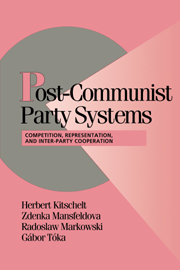Book contents
- Frontmatter
- Contents
- List of Figures and Tables
- Acknowledgments
- Introduction: Democracy and Party Competition
- Part I Theory: Party Systems and the Procedural Quality of Post-Communist Democracy
- Part II Setting and Research Strategy
- Part III The Structuring of Party Competition
- Part IV Political Alignments and Dimensions of Competition
- Part V Political Representation and the Quality of Democratic Governance
- Conclusion
- Appendix I List of Political Parties and Electoral Alliances
- Appendix II Questionnaire for the Elite Study
- Appendix III Population Survey Questions (Policy Opinions)
- Bibliography
- Index
- More Titles in the series
Introduction: Democracy and Party Competition
Published online by Cambridge University Press: 05 June 2012
- Frontmatter
- Contents
- List of Figures and Tables
- Acknowledgments
- Introduction: Democracy and Party Competition
- Part I Theory: Party Systems and the Procedural Quality of Post-Communist Democracy
- Part II Setting and Research Strategy
- Part III The Structuring of Party Competition
- Part IV Political Alignments and Dimensions of Competition
- Part V Political Representation and the Quality of Democratic Governance
- Conclusion
- Appendix I List of Political Parties and Electoral Alliances
- Appendix II Questionnaire for the Elite Study
- Appendix III Population Survey Questions (Policy Opinions)
- Bibliography
- Index
- More Titles in the series
Summary
The collapse of communism across Eastern Europe was one of the final manifestations of a worldwide spread of democratization over a twenty-year period that began with Southern Europe in 1974, then continued in Latin America in the 1980s and subsequently moved on to Eastern Asia in the late 1980s and 1990s. Political scientists devoted much effort to account for the timing and modalities of political-regime change and the structural conditions and dynamic processes that made possible this “Third Wave” of democratization (Huntington 1991). But as we approach the turn of the century, we have only the most sketchy understanding of the practice of democratic competition, representation, and policy making in these new democracies. Political scientists have delivered few theoretically incisive comparative analyses of the way the new democracies actually work.
Much of the political science discourse is still mesmerized by an almost exclusive concern with the “survival” or “consolidation” of basic democratic regime parameters in Third Wave democracies, such as civil liberties, free elections, and legal-bureaucratic predictability. Contributors to this debate seek to specify the minimal conditions that make democratic rules of the game persist over time (cf. Linz and Stepan 1996: 7–37). But there may be no one set of baseline features that keeps democracy alive. Moreover, the focus on holistic questions of democratic consolidation has diverted attention from the specific mechanisms of electoral competition and legislative representation as well as the modes of interest intermediation in the policy-making process, all of which contribute to breathing life into the democratic framework.
Information
- Type
- Chapter
- Information
- Post-Communist Party SystemsCompetition, Representation, and Inter-Party Cooperation, pp. 1 - 16Publisher: Cambridge University PressPrint publication year: 1999
